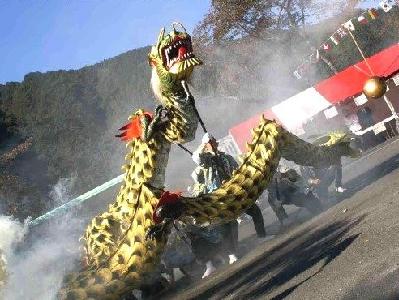|
Sakuma Dam Festival is a citizen festival held on the last Sunday in October at Sakuma Dam in Hamamatsu City, Shizuoka Prefecture. It started in 1957 in memory of the victims to their duty of dam construction and in hope of the long successful operation of the dam.
When the dam was completed, red and black carp were brought from the water moat of the Imperial Palace and released into the dam lake as the guardian gods; thereby the parade of the Dragon God and the Dragon Dance is performed. Dashing seven young men wearing festival jackets and hair bands skillfully operate the Dragon God, which is 15 m long and weighs 60 kg, and perform a valiant dragon dance. It is distinctive that this dragon god has carp scales.
Other events such as the Sakuma Hiryu Daiko drum performance, various street performances, the Japanese noodle quick eating contest, the throwing rice cake contest and the local products fair are held in the lakeside field. Hand-held peacock fireworks are displayed on the lake. A lot of local people come to enjoy the festival on this day.
When the dam was completed, red and black carp were brought from the water moat of the Imperial Palace and released into the dam lake as the guardian gods; thereby the parade of the Dragon God and the Dragon Dance is performed. Dashing seven young men wearing festival jackets and hair bands skillfully operate the Dragon God, which is 15 m long and weighs 60 kg, and perform a valiant dragon dance. It is distinctive that this dragon god has carp scales.
Other events such as the Sakuma Hiryu Daiko drum performance, various street performances, the Japanese noodle quick eating contest, the throwing rice cake contest and the local products fair are held in the lakeside field. Hand-held peacock fireworks are displayed on the lake. A lot of local people come to enjoy the festival on this day.
| [+ADDRESS] | 
|



















